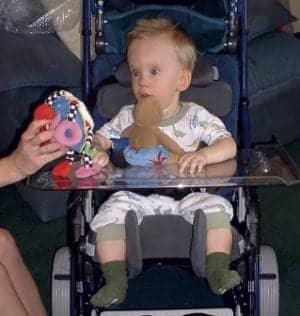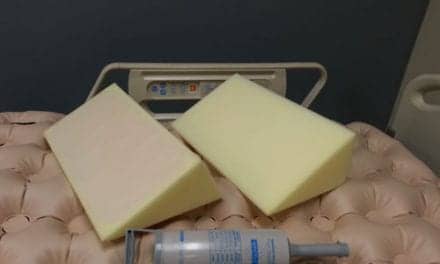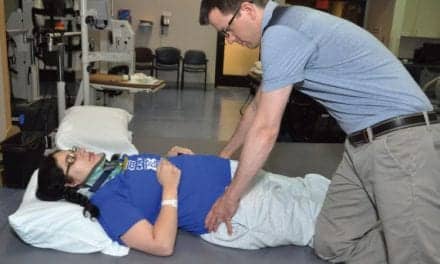
Kyle, who was born with schizencephaly, hydro- cephalus, seizures, and cortical vision impairment, has been the author’s client since age 4 months.
Photography supplied by the author, Otto Bock, and Sunrise Medical
Kyle is a 9-year-old boy who has two little sisters, attends elementary school, and loves riding in a boat at the lake. He recently traveled to his uncle’s wedding in Hawaii. You could say that mobility is important for Kyle, but it took years to find solutions that suited him.
I met Kyle at age 4 months in 2000. Born with schizencephaly, hydrocephalus, seizures, and cortical vision impairment, Kyle’s seizures are controlled with a ketogenic diet and medication. He is shunted and has a gastrostomy tube. Kyle presented with extreme hypertonia and spasticity in his extremities, low trunk tone, no head control, and a high activity level. He really liked to move but his repertoire was limited. Without therapeutic handling and positioning Kyle’s patterns of extension predominated to the point of opisthotonos. He was visually alert and interactive when given proper support, but was often irritable secondary to his neurological state, and slept poorly.
FINDING A TOLERABLE SYSTEM
Kyle was the firstborn child of his parents—a couple who own an outdoor sports equipment store. They led an active lifestyle, but Kyle did not tolerate a stroller or car seat. It was difficult to take him anywhere, and he was happiest being held or riding in a front baby carrier. Helping Kyle find contentment outside his parents’ arms and including him in family activities were priorities, and their first desire was to use traditional baby equipment so that is where we began. Firm padding under his car seat cover gave Kyle extra lateral support at his trunk and head to help him feel more secure, and allowing him to tolerate the car seat for up to 15 minutes. Next we put a feeder seat in a borrowed jogging stroller, and Kyle occasionally tolerated 20 minutes in it, always happiest when bumping along. The feeder seat fit on a high chair but was discontinued as Kyle’s tolerance for it declined. His parents bought a stroller with suspension and borrowed a relative’s high chair with special features in attempts to keep Kyle content.
At age 7 months, Kyle’s sitting tolerance was less than when he was younger. His mother experienced joint pain from holding and positioning him full-time, and could not accomplish any activities during the day. Kyle sometimes required extended periods of therapeutic handling before he could relax. We experimented with hip angle adjustments using a bath chair with separately adjustable seat and back as a positioning chair, in the process discovering that Kyle liked the mesh seat that allowed him to move—his first experience of dynamic seating.

Finding a comfortable, effective, and dependable mobility system can present new challenges as a child ages.
At age 10 months, back pain prohibited Kyle’s mother from carrying him in the front baby carrier; she wanted to try a backpack but Kyle’s poor head control made that impossible. Approaching his first birthday, Kyle’s longest sitting tolerance in any equipment was 20 minutes and his mother doubted that anything would ever work well. We had established that Kyle was most comfortable with his hips flexed and abducted to an extreme degree, with lumbar support and no pressure at his occiput. Utilizing these principles Kyle was able to sit with support and partially control his head. At age 14 months his parents decided to abandon baby equipment, and focus on finding an appropriate seating and mobility device. A medical supplier was called to help find a solution for Kyle.
Kyle demonstrated a need for tilt-in-space to help manage his tone, and for gravity relief to facilitate head control. A trial mobility device ordered to Kyle’s measurements arrived almost 1 year after I had first met him. We customized the seat by creating an extreme ischial ledge, and lateral thigh supports were used medially as a wide abductor. The footplate was set below his feet, allowing them to fall in a natural position without plantar surface input that stimulated extensor posturing.
Over the next 4 months, we kept modifying the trial seating. A sub-occipital head support with lateral pads as boundaries worked best, and Kyle’s head control improved with anterior support from a dynamic chest harness and tray. As seating modifications were refined, Kyle spent several 1-2 hour sessions in his chair each day. He was still happiest when the stroller was moving, but for the first time he was content outside his parents’ arms. This dependent mobility device was eventually purchased through insurance and Medicaid and served Kyle well for 3 years.

A lightweight pediatric rigid chair, with multiple features and options, can be a preferred mobility system for some children.
In 2005 at age 4, Kyle attended pre-school and his world had expanded. We made foam inserts so that he could ride in a backpack for short periods, and experience the world from a bike trailer/stroller combination. Dynamic foam inserts allowed Kyle to move while giving him the support he needed. During this year Kyle’s head and trunk control varied with seizure activity changes. His head began to fall forward and became caught on the sub-occipital and lateral pads, necessitating change to keep him safe. During re-evaluation Kyle exhibited improved head control in response to slight downward and backward support at his shoulders, and his mother obtained the same results on subsequent days. Trial with a head support and shoulder retractor system was recommended and these were mounted on a borrowed tilt-in-space chair. Kyle could raise his head to rest on the sub-occipital support without assistance and the retractors provided lateral boundaries.
During this trial period Kyle was observed moving in the chair by pushing on his footrests, yet he remained sitting in good alignment. We found the seat pan was bent and as such offered an accidental dynamic component that Kyle loved! This confirmed again what he really needed—a dynamic frame—although it would be years before we were successful in providing one. Still, he did quite well in a planar seating system with biangular back, four-point pelvic belt and the head support/shoulder retractor system. A tilt-in-space wheelchair with these features was purchased for Kyle, and his parents got busy to ensure that he could accompany them on trips to the beach and over other rough terrain. A friend designed and welded attachments that converted the frame to a three-wheel “beach chair.” At last Kyle could sit well and go off road!
DYNAMIC OPTIONS

Over the years, Kyle has undergone a series of trials with tilt-inspace chairs, head supports, and shoulder retractor systems.
As we learned of dynamic frame options we tried them all. Kyle’s first grade special education teacher advocated for a school chair so he could sit at different heights to participate with his class. I suggested a chair with shoulder retractors and a dynamic back on a high-low base, Kyle tried and liked it, and the school purchased it. We tried other dynamic frames over the years without success. One chair was too wide for the tie downs in Kyle’s van and did not accept his seating system. Another accepted Kyle’s seating, but it was too difficult to “lock out” the dynamic component during transportation. Combining Kyle’s needs with a dynamic frame seemed an elusive goal.
In 2008 Kyle was 7 years old, and he began rotating out of the planar seat that had previously stabilized his pelvis well. Transition to a custom molded seat cushion offering aggressive pelvic control was recommended, and with the new cushion Kyle once again maintained his posture with minimal lower body extension and rotation. This lasted through the school year, but by the summer of 2009, Kyle’s posture had declined again, with a mild scoliosis and associated deviations resulting in left forward rotation of his trunk. Planar seating was inadequate to address Kyle’s need for support and accommodation, so transition to a custom molded backrest was recommended and the adventure began. We chose a method that provided intimate back contact for support and correction of Kyle’s posture. We knew it had to work well with his head and shoulder support system, and the dynamic seating dream was still out there. Over the next 6 months, we struggled to incorporate everything into one dream system for Kyle.
Along the way we did a remake of his molded back, and achieved a good result only to discover that constant pushing backward continually loosened the backrest hardware. Around this time I searched the internet for dynamic seating and discovered something new to me—a component that could be added to make an existing frame dynamic. We tried it on Kyle’s 4½-year-old frame and it worked! At age 9, Kyle could finally stretch with proper support and alignment. His hardware no longer loosened, and the system was easy to lock in place for transportation. Having settled on Kyle’s dream system, a new frame was ordered to accommodate his growth. Kyle received his new chair in January 2011, and enjoys mobility both in his world and in his wheelchair seating.
Tamara Kittelson-Aldred, MS, OTR/L, ATP, is an occupational therapist specializing in positioning, seating, and wheelchair mobility for children and youth through Access Therapy Services (www.accesstherapyservices.com) in Missoula, Mont. She can be reached at .




